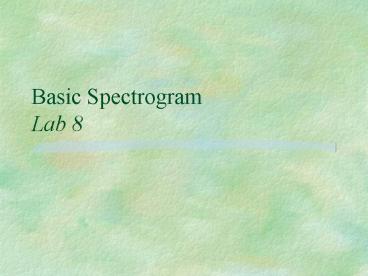Basic Spectrogram Lab 8 - PowerPoint PPT Presentation
1 / 20
Title:
Basic Spectrogram Lab 8
Description:
Wide Band Spectrogram. Digital Signal Processing. Basic objective of digital signal processing: ... and narrow band spectrograms of the following, stressing ... – PowerPoint PPT presentation
Number of Views:143
Avg rating:3.0/5.0
Title: Basic Spectrogram Lab 8
1
Basic SpectrogramLab 8
2
Spectrograms
- Spectrograph Produces visible patterns of
acoustic energy called spectrograms - Spectrographic Analysis
- Acoustic signal changes rapidly continuously
- Need a dynamic analysis revealing spectral
features - Short term running spectrum
3
Spectrographic Analysis
- Time, Frequency intensity
- Time (horizontal axis) Phonetic elements will be
from left to right - Frequency (Vertical axis) Increasing in upward
direction - Intensity represented by a gray scale or as
variations in darkness
4
Dimensions of Spectrograms
A. Burst of noise
B. Vowel with 4 formants
Time
C. Noise with high frequency energy
5
Source/Filter
- Resonator Source Energy
- Filter Vocal tract
- Energy passed in a frequency selective manner
- Production of different vowels changes the filter
shape - Source Harmonic spectrum of voicing
- Fundamental frequency its harmonics
- Source spectrum is the acoustic energy activating
the formants - Source-filter theory of vowel production
- The energy form the source (vibrating vocal
folds) is modified by the resonance
characteristics of the filter (vocal tract)
6
Formants- Filter
- Are formed through resonation of sound in the
vocal tract (filter function) - Can only see through a wide band spectrogram
F2
F2
F1
7
Harmonics- Source
Harmonics (Spectrum)
Harmonics(Spectrogram)
8
Source-Filter Theory
9
Source-Filter
10
Wide Band vs. Narrow Band
- Wide Band analyzing filter wide, 300-400 Hz
- Good to show formants because they have a wide
spread of acoustic energy - Narrow Band analyzing filter is of higher
resolution, 100 Hz - Good to show the harmonics of source spectrum
11
Bandwidth
Narrow Bandwidth (Harmonics)
Wide Bandwidth (Formants)
12
Continuous Spectrum Bandwidth
13
Vowel Wide Band vs. Narrow Band
14
Wide Band Spectrogram
Fricative noise Above 3 or 4 kHz
Diphthong Horizontal bands of energy
15
Digital Signal Processing
- Basic objective of digital signal processing
- Convert the analog acoustic signal (Panel A) to a
digital form (series of s) - How do we get a waveform into a digital computer?
- Analog-Digital conversion (A-D) results in
samples of time and amplitude - Correct sampling rate is important to reconstruct
the wave form - Sampling rate must be 2x the bandwidth of
analysis Nyquist Frequency - Ex. Sample speech with a bandwidth of 5000 Hz,
than the sampling rate should be 10,000 Hz
16
Analog-Digital Conversion
b. Time sampling intervals
17
Laboratory
- Part I Recording the sample- Sampling rate
- Set sampling rate for shortest duration possible
- Sustain /a/ open 3 views to print all samples
on 1 screen - Sample at 20,000 samples/sec look at 5-6 cycles
- Sample at 5,000 samples/sec look at 5-6 cycles
- Sample at 2,500 samples/sec look at 5-6 cycles
- What happens as sampling rate drops
- Narrow band filter each sample (print each)
18
Laboratory
- Part II Filter bandwidth
- Record I am tall
- Wide band and narrow band the statement
- Find the following characteristics on one or both
of the spectrograms - Harmonic lines
- Formant bands
- Vertical striations
- Acoustic indication of release of air pressure
for /t/ - Which has better frequency resolution? Time
resolution? Which can you determine formant bands?
19
Laboratory
- Part II Cont.
- Make wide and narrow band spectrograms of the
following, stressing the underlined word - I am tall
- I am tall
- I am tall
- I am tall?
- Which spectrograms show the intonation contour?
Mark the contour on one of your printouts
20
Laboratory
- Part III Changing the Filter
- Say /iui/ without changing intonation
- Prepare 2 spectrograms of this utterance
- 1st- 2xs your fundamental frequency
- 2nd- no more than half your fundamental
- Answer questions
- Label each vowel on each spectrogram
- Harmonics
- Formants































